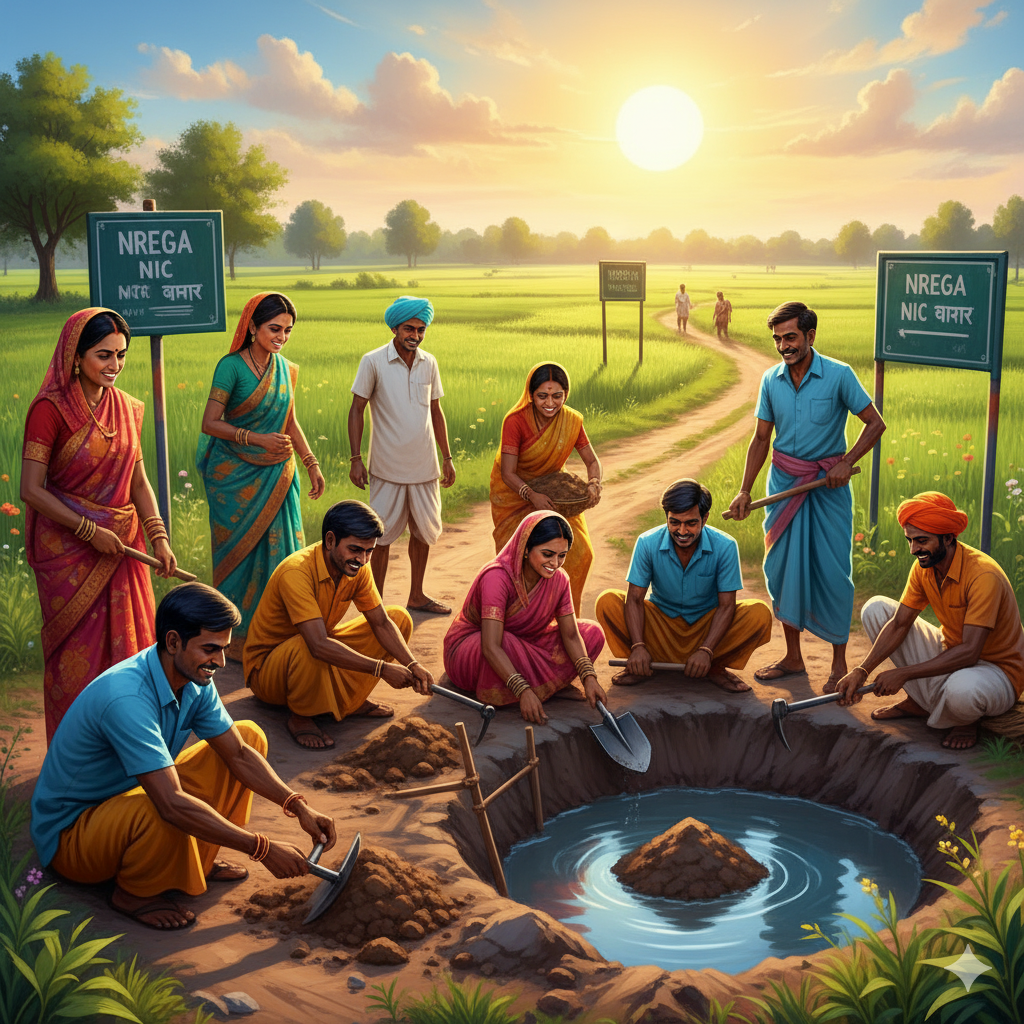You know, NREGA NIC in Bihar has become this key term that really captures where tech, government oversight, and everyday rural livelihoods come together in one of India’s biggest social initiatives. Beyond the simple job card and those daily attendance sheets, there’s this massive national IT setup run by the National Informatics Centre (NIC) that handles everything from tracking to reporting and ensuring accountability for MGNREGA in thousands of Gram Panchayats across Bihar. In this in-depth guide, I’ll break down what NREGA NIC in Bihar truly involves, how tools like NREGASoft, SECURE, NMMS, and others get used at the block and panchayat levels, the strong points and areas that still need work, and how regular folks can tap into these digital resources to stand up for their rights.
I’ll weave in related terms like NREGASoft, job card, muster roll, Aadhaar-seeding, SECURE estimates, NMMS attendance app, Gram Panchayat data entry, and MIS reporting naturally throughout, so we cover both the tech side and the real-world application. I’ve also drawn from typical headings in other guides and reports, turning them into fresh, original sections that serve as a hands-on manual, a policy breakdown, and a practical resource for citizens.
What “NREGA NIC in Bihar” Actually Refers To
When folks mention NREGA NIC in Bihar, they’re talking about the collection of apps hosted by NIC, along with state-specific tweaks and digital processes that keep MGNREGA running smoothly in the state. At its core is NREGASoft, the main management information system that tracks job cards, muster rolls, work plans, payments, and overall progress. For Bihar, this ties into NIC’s SECURE for consistent estimates and the NMMS app for location-based attendance. All these elements create a clear digital record for countless rural projects and millions of workdays. These NIC systems aren’t just websites; they’re the proof trail that lets people, officials, and auditors verify if a project happened, who was involved, and if payments went through.
Why the NIC Architecture Matters for Bihar’s Rural Economy
Bihar’s countryside relies a lot on this guaranteed work as a safety net, a way to earn during slow seasons, and a means to build essential local infrastructure like roads, ponds, and check dams. NREGA NIC in Bihar plays a huge role because it cuts down on information gaps: with job cards and open MIS reports, villagers can check if wages hit their accounts, what projects got approved, and if the promised workdays actually materialized. By putting everything online, the NIC setup aims to plug leaks, speed up payments, and offer live proof for complaints and checks. This is especially vital in Bihar, where the sheer scale and administrative hurdles make old-school paper systems prone to mistakes and slowdowns.
The Core Components You Need to Know — NREGASoft, SECURE, NMMS and More
The heart of NREGA NIC in Bihar boils down to a few connected systems that work together seamlessly.
NREGASoft is the main MIS hub. In Bihar, it handles every job card entry, muster roll, project approval, payment, and report generation that’s accessible to the public and higher-ups. It’s the go-to spot for district and block staff to input data and for everyday people to pull reports on their Gram Panchayat.
SECURE is NIC’s tool for crafting technical and financial estimates for MGNREGA projects. In Bihar, it standardizes these estimates online, sharing them with NREGASoft once approved, which helps avoid mismatches between what’s planned and what’s done, while making costs clearer.
NMMS, or the National Mobile Monitoring Service, is an app that logs daily attendance with photos tagged to locations, boosting fieldwork checks and letting citizens keep an eye on things. The app ensures muster rolls match who’s actually showing up at sites.
Put together, these pieces are what people really mean by NREGA NIC in Bihar: a system driven by data that’s easy to audit and track.
How the System is Organized on the Ground: Gram Panchayat to State HQ
The NIC tools stack up across different levels of administration in Bihar. Down at the Gram Panchayat, data gets captured in ways that fit local life: issuing job cards, keeping daily attendance, and uploading records from the village. Block offices step in with tech help, approve estimates, and input approvals. Districts pull it all together, check for accuracy, and manage funds and reports. At the state level, the Rural Development Department and NIC team oversee hosting, monitoring, and auditing the big-picture data and policies. This chain from bottom to top turns on-the-ground realities into statewide and national MIS stats. If something breaks—like slow uploads at the GP, missing bank details, or unfinished estimates—the digital record pinpoints the issue.
Competitor Headings Scanned and Reimagined as Fresh Sections
I’ve looked at how other guides and reports structure their content, spotting common titles like “What is NREGASoft?”, “How to check job card”, “How to file a complaint”, “How payments are processed.” Here, I’ve refreshed those ideas into new, more detailed parts that keep the useful vibe but skip any repeats.
What is NREGASoft and Why It’s Central to NREGA NIC in Bihar
NREGASoft serves as the MIS foundation. For Bihar, that means every job card detail, muster roll, approval, and payment flows through it or a linked NIC tool. It auto-generates MIS reports showing workdays per GP, stalled projects, pending wages, and comparisons across areas. Basically, it turns paper logs into a searchable, dated public archive and sets the standard for measuring success. For folks on the ground, it’s the starting point if wages are late or a project doesn’t match up—the system makes it easier to spot and fix issues.
How to Find and Download Job Card Lists in Bihar Using NIC Tools
Other sites often list steps one by one, but here’s the straightforward way: Head to the state GP reports in the MIS, pick Bihar, drill down by year, district, block, and Gram Panchayat to see job card lists and work registers. You can download these, which helps confirm if names are on active cards or if someone’s been marked inactive. For regular people, this openness is a key shield against lost wages or oversight slip-ups.
How Payments Reach Workers: ABPS, Aadhaar Seeding and the Digital Trail
One thing that gets a lot of flak is wage delays. In Bihar’s NREGA NIC setup, many areas use the Aadhaar-based Payment System (ABPS), so once attendance is okayed and checks are done, the payment order goes straight to the bank for deposit. The NIC keeps tabs on status—like “payment started,” “in process,” “deposited”—so you can see where it’s stuck. Getting Aadhaar and bank links right is key to dodging holdups.
SECURE Estimates: Why Standardized Technical Estimates Matter in Bihar
SECURE offers ready templates for typical MGNREGA projects, making costs and labor clear and checkable. In a state like Bihar with tons of small jobs yearly, it cuts back on wiggle room that could lead to padded costs. The online link between SECURE and NREGASoft means approved estimates show up in the MIS for tracking and payouts. This connection is how NREGA NIC in Bihar tries to blend precise planning with clear execution.
Common User Journeys Explained
To keep things real and helpful, let’s walk through some everyday scenarios—how a worker or villager might use the NIC tools in practice.
Say a worker wants to confirm if wages landed: They’d use their job card number in the MIS to check payment status. If it says “paid” but the account’s empty, that NIC info proves the order went out, likely pointing to a bank lag.
For a Panchayat staffer uploading attendance: They’d grab geotagged shots via NMMS if possible, or match paper records to MIS if offline. The setup handles both mobile capture and web uploads.
If someone’s verifying a project’s estimate: They’d go to the SECURE-tied entry to see breakdowns on costs, labor, and materials—making it simpler to flag if things don’t line up. These are the kind of routine uses that turn NREGA NIC in Bihar into something practical, not just data storage.
Mistakes and Delays That Commonly Show Up in the NIC Trail
Even with all the digital bells and whistles, errors pop up and are visible in the NIC MIS: things like repeated job cards, spotty Aadhaar links, mismatches in attendance and payouts, or projects listed as done when locals say otherwise. When the record shows a glitch, it turns into ammo for fixing it—whether chatting with block engineers, district officers, or using grievance paths in the MIS. The digital trail doesn’t wipe out mistakes, but it makes them harder to hide and gives people solid facts for pushing back.
How Gram Panchayats and Block Offices Use the NIC Tools Day to Day
At the village level, clerks and secretaries log into NIC web portals to make job cards, track attendance, and upload work docs. Blocks handle SECURE for estimates, then feed approvals into the MIS. Districts review uploads for oddities and compile for the state. In real life, this means having trained folks, devices, and steady connections at Panchayats is as crucial as the software—the tools shine only when people know how to use them.
NMMS and Geotagging: Strengthening On-Site Verification in Bihar
The NMMS app lets field staff snap real-time attendance pics with location tags. In a state like Bihar that’s varied and prone to floods, this ups the game for checks: locals, auditors, and groups can verify if the spot and photo match the reported site. It’s a prime example of how NREGA NIC in Bihar mixes mobile tech with efforts to keep things honest.
Data Transparency and Public Reporting: What the Public MIS Shows for Bihar
Open dashboards for Bihar highlight big numbers: active job cards, workdays created, average days per family, total spending, and breakdowns by district. These let community groups compare blocks and spot issues needing fixes. For everyday folks, the MIS is the clearest part of NREGA NIC in Bihar—a free, open record to check services without middlemen.
Practical Problems That Still Plague the NIC Workflow in Bihar
Despite the systems, Bihar deals with ongoing hitches: shaky internet in villages, skimpy training for data folks, Aadhaar-bank mix-ups, workers moving for seasons leaving jobs unfinished, and sometimes estimates not matching supplies. These are about processes, skills, and basics that tech can’t solve alone. Smart use of NREGA NIC in Bihar means investing in training, local gear, power backups, and regular checks to bridge data and reality.
Success Stories and Positive Signals
There are real bright spots with NREGA NIC in Bihar. Faster wages in some districts, clearer project views via MIS, and tighter estimates through SECURE have cut some corruption and waits. Areas testing NMMS show better attendance accuracy and more trust from locals. These small victories highlight how well-coordinated digital tools can boost results when backed by good local management.
How to Check Your Job Card, Payment and Work Status — a Citizen’s Checklist
If you’re a worker or villager wanting to use NREGA NIC in Bihar for your rights, here’s a simple rundown:
Go to the state/GP reports on the MGNREGA MIS.
Pick Bihar, the year, district, block, and Gram Panchayat.
Click into job card or payment reports for lists, attendance entries, and statuses.
If something’s off—like your name or wage missing—note the MIS detail and complain at the Panchayat or block; escalate via the portal’s grievance options if needed.
This checklist makes the NIC MIS a real tool for people.
The Policy and Governance Levers That Determine How Well NREGA NIC Works
NREGA NIC in Bihar fits into a bigger governing picture. Timely funds, clear estimate rules, teamwork between rural development and state NIC, and drive to fix MIS issues set the tone for success. Tech spots gaps but doesn’t fix cash flows or admin woes. Real progress pairs digital openness with strong follow-through and public watchdogs.
Frequently Asked Questions About NREGA NIC in Bihar
What is NREGA NIC in Bihar and Why is It Important
NREGA NIC in Bihar covers the NIC-run software like NREGASoft, SECURE, and NMMS that track job cards, attendance, estimates, and payments for MGNREGA in the state. It’s key because it builds a checkable, open record for rural jobs and wages.
How Can I Check My Job Card on NIC Systems
Hit the public MIS on the MGNREGA site, choose Bihar, year, district, block, and Panchayat to get job card lists and work logs.
Why Do Wage Payments Get Delayed Even When NREGASoft Shows Payment Created
Holdups might come from bank waits, Aadhaar-bank errors, or unfinished approvals. The MIS helps pinpoint the snag.
What is SECURE and How Does It Relate to NREGASoft
SECURE handles standard estimate building. Once approved, it links to NREGASoft so project costs show in the MIS.
What is the NMMS App and How Does It Improve Verification
NMMS captures location-tagged attendance photos at sites, ensuring listed workers were there.
How Can I Raise a Grievance if My Wages Are Not Credited
Grab the MIS ref for your card or wage, start at Panchayat/block, then use the portal’s complaint system or go to district officials.
How Many Job Cards and Person-Days Does Bihar Show on the MIS
The public MIS lists hundreds of lakhs of cards and crores of workdays lately; check Bihar’s page for district details.
What Should Panchayat Staff Do to Ensure NIC Systems Work Properly
Keep gear and connections ready, accurate attendance, full Aadhaar-bank ties, and join trainings on SECURE and NREGASoft.
Final Words: Turning Data into Dignity in Bihar
NREGA NIC in Bihar isn’t the goal—it’s a means to an end. Done right, it bolsters rights, cuts waits, and highlights issues for demands. Done wrong, it’s just a pile of glitches and lost chances. The takeaway? Digital clarity plus local skills and commitment lead to lasting change. For Bihar, that means funding not just tech but the village-level operators and watchdogs keeping it real. With those, NREGA NIC can keep reshaping rural job guarantees for the neediest families.








